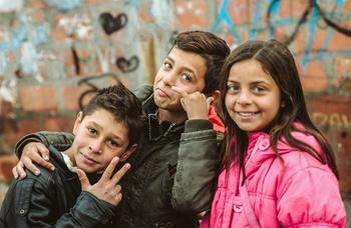Discrimination cannot be fought without allies

Despite major advances in recent decades in both the development of methods to reduce prejudice and EU policies to promote Roma integration, there has been no significant change in the social situation of the Roma population in Europe, according to researchers from the ENGAGE project led by the ELTE PPK consortium after two years of work. In a previous international study based on a representative survey, ELTE social psychologists pointed out that the biggest obstacle in Europe is the indifference of the majority of society.
"This is a huge problem, because to say 'I don't care' to a racist statement is not a neutral position at all," explains Anna Kende, project leader and lecturer at ELTE PPK. In a high-profile project involving Slovak, Spanish and Hungarian experts, the aim is to find out how to create social solidarity and increase the willingness to act among Roma and non-Roma. Participants
used a variety of research methods to examine the effectiveness of different interventions.
As a first step of the multi-pillar project, the researchers conducted a second analysis of the Eurobarometer and European Social Survey data on discrimination from 2019. The survey, covering 17 European countries, clearly showed that contact between Roma and non-Roma is associated with lower levels of prejudice. "However, the positive effect of intergroup contact was less pronounced in countries with higher levels of prejudice, but was found across all cultures. Positive contact with the other group therefore remains one of the most effective ways of changing attitudes," stresses Anna Kende.
But what intervention strategies can effectively change the current relationship between Roma and non-Roma and thereby reduce social inequalities? The answer to this question is complicated by the fact that recent studies suggest that, while more frequent interaction between the two groups may improve attitudes, it may also reduce the motivation of Roma to stand up for their rights. Social psychologists have analysed good practices in Hungary, Spain and Slovakia and found that the most effective methods of relationship building involve Roma in the planning and implementation phases, and present Roma culture, history and problems without taboos, while appealing to the empathy of the majority population.
Examples of good practice include the sensitisation training sessions of the UCCU Roma Informal Education Foundation, which are designed and run by the organisation's Roma volunteers in educational institutions. In these sessions, participants are free to share their opinions, report on their conflicts and ask often stereotypical questions about Roma. In this respect, the workshop is also a niche event, since, in addition to media distortions and other discredited sources
the average non-Roma has little chance of gaining factual knowledge about Roma.
Meeting and learning about the personal stories of Roma helps non-Roma to become more socially sensitive and empathetic, and to see the complexity of social problems. It also encourages Roma youth to raise their voices by offering knowledge and awareness about Roma culture and identity. (You can read more about other good practices identified in the ENGAGE project here.)
The research team also looked at how non-Roma can be mobilised to take action to improve the situation of Roma, involving more than 700 Hungarian and Spanish students. After answering a series of questions about their experiences and attitudes towards Roma, the participants were divided into two groups. One half of the group was asked to read a fictional newspaper article about how, thanks to the coalition, non-Roma had been able to achieve real and positive social change for the benefit of Roma. The article given to the other group, on the other hand, said that despite their joint efforts, the situation of Roma had not improved. A questionnaire survey was then carried out and participants were asked to sign an otherwise fictitious petition in support of Roma equality.
Analysis of the feedback received showed that those who read the article on the positive impact of the coalition were more likely to support Roma or take part in actions for equal rights. The experiment clearly confirmed that the willingness to act can be effectively increased if people believe that they are the ones who can make a difference in society. "At the same time, we also saw that a higher number of people who signed the petition were those who were aware of the discrimination faced by Roma and had experienced first-hand the disadvantages they face when, say, renting a flat or getting a job," says Anna Kende.
highlighting inequalities is key to mobilising people,
but that alone is not enough."
The researchers didn't stop there, they put the results from these studies to the test. This involved interviews with 32 Roma activists to find out what they think is needed to achieve social change. The majority of the interviewees said that cooperation with different groups - Roma, non-Roma and other minorities - is essential to improve the situation of Roma, and that allies can come from any background.
According to the participants, important characteristics of a "good" ally include a willingness to listen to others and learn from their mistakes, a willingness to stand up for the cause while not feeling superior, and a willingness to give space to Roma. But this is not always an easy task. As one of the Roma activists interviewed pointed out, "people are able and willing to give money, but very few are willing to give themselves for the cause".
Based on the results of the two-year project, the researchers have developed a guide for relationship-based interventions to promote social inclusion, and the importance of allies has been demonstrated in a video.
Photo: Zoran / Adobe Stock

